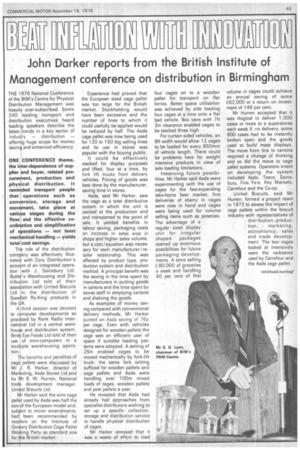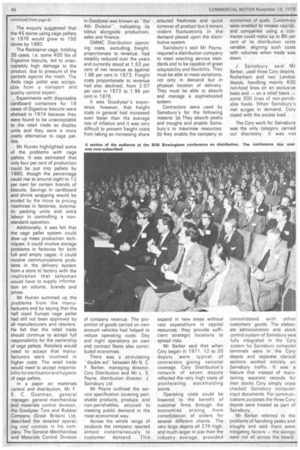John Darker reports from the British Institute of Management conference on distribution in Birmingham
Page 47

Page 48

If you've noticed an error in this article please click here to report it so we can fix it.
THE 1976 National Conference of the BIM's Centre for Physical Distribution Management was heavily over-subscribed. Some 240 leading transport and distribution executives heard leading speakers describe the latest trends in a key sector of indus ry — distribution — &fen g huge scope for money savin and enhanced efficiency.
ONE CONFERENCE theme, the i ter-dependence of supplier nd buyer, related procure ent, production and physical distribution. It reminded transport people that operations such as conversion, storage and movement, take place at various stages during the flow, and the effective coordination and simplification
of erations — not least mec anical handling — yields total cost savings.
Th role of the distribution corn any was effectively illustrate with Cory Distribution's acco nt of an integrated operation with J. Sainsbury Ltd. Butle 's Warehousing and Distribu ion Ltd told of their ass iation with United Biscuits Ltd in the distribution of Swe ish Ry-King products in the yK. A third session was devoted to computer developments as practised by Rank Radio Internaticnal Ltd in a central warehouse and distribution system. Birds Eye Foods Ltd told of their use of mini-computers in a mul iple warehousing operation.
The benefits and penalties of cage pallets were discussed by Mr J. R. Harker, director of Marketing, Asda Stores Ltd and by Mr B. W. Hurren, National trade development manager, United Biscuits Ltd.
Mr Harker said the wire cage pallet used by Asda was half the size of the European model and, subject to minor amendments, had been recommended by retailers on the Institute of Grocery Distribution Cage Pallet Working Party as standard size for the British market. Experience had proved that the European sized cage pallet was too large for the British market. Stockholding would have been excessive and the number of lines to which it could usefully be applied would be reduced by half. The Asda cage pallet was now being used for 120 to 150 big selling lines and its use in stores was popular with the buying public.
It could be effectively stacked for display purposes and lifted, four at a time, by fork lift trucks from delivery vehicles. Pricing of goods was best done by the manufacturer, saving time in stores.
Asda, said Mr Harker, saw the cage as a total distributive system in which the unit is packed at the production end and transported to the point of sale. It yielded benefits in labour saving, packaging costs an increase in sales area in shops and higher sales volume, but a cost/equation was necessary for each manufacturer/retailer relationship. This was affected by product type, production system and distribution method. A principal benefit was the saving in the time spent by manufacturers in putting goods in cartons and the time spent by stores staff in emptying cartons and shelving the goods.
As examples of money saving compared with conventional delivery methods, Mr Harker quoted an Asda saving of 76p per cage. Even with vehicles designed for wooden pallets the cage was an efficient user of space if suitable loading patterns were adopted. A setting of 25in enabled cages to be moved mechanically by fork-lift truck; the same fork setting sufficed for wooden pallets and cage pallets and Asda were handling over 100m mixed loads of cages, wooden pallets and post pallets a year.
He revealed that Asda had already had approaches from specialist distributors wishing to set up a specific collection, storage and distribution service to handle physical distribution of cages.
Mr Harker stressed that it was a waste of effort to load four cages on to a wooden pallet for transport on flat lorries. Better space utilisation was achieved by side loading four cages at a time onto a flat bed vehicle. Box vans with 7ft 3in clearance enabled cages to be stacked three high.
For curtain sided vehicles, an 8ft width would allow 12 cages to be loaded for every 850mm of vehicle length. There could be problems here for weight intensive products in view of axle loading limitations.
Instancing future possibilities, Mr Harker said Asda were experimenting with the use of cages for the fast-expanding take-home beer market; first deliveries of sherry in cages were now in hand and cages were being used for volume selling items such as potatoes. The advantage of a regular sized display unit for irregular shaped packages opened up enormous .possibilities for future packaging developments. A store selling £ 80,000 of groceries a week and handling 40 per cent of that volume in cages could achieve an annual saving of some £62,000 or a return on investment of 149 per cent.
Mr Hurren accepted that it was illogical to deliver 1,000 cases or more to a superstores each week if, on delivery, some 600 cases had to be instantly broken open and the goods used to build mass displays. The move from tins to cartons required a change of thinking and so did the move to cage pallet systems Operators intent on developing the system included Asda, Tesco, Sainsbury, Fine Fare, Key Markets, Carrefour and the Co-op.
United Biscuits, said Mr Hurren, formed a project team in 1973 to assess the impact of cage pallets within the biscuit industry with representatives of dist-ibution, produc
tion, marketing, accountancy, sales and trade developmert. The two cages looked at intensively were the racktainer used by Carrefour and the Asda cage pallet. The enquiry suggested that the 45 stores using cage pallets in 1976 would grow to 150 stores by 1980.
The Racktainer cage, holding 36 cases, i.e, some 400 lbs of Digestive biscuits, led to unacceptably high damage to the product, due to pressure of the packets against the mesh. The Asda cage pallet was acceptable from a transport and quality control aspect.
Experiments with disposable cardboard containers for 18 cases of Digestive biscuits were shelved in 1974 because they were found to be unacceptable to the retail trade as display units and they were a more costly alternative to cage pallets.
Mr Hurren highlighted some of the problems with cage pallets. It was estimated that only four per cent of production could be put into pallets by 1980, though the percentage could rise to around eight to 12 per cent for certain brands of biscuits. Savings in cardboard and shrink wrapping would be eroded by the move to pricing machines in factories, automatic packing units and extra labour in controlling a nonstandard operation.
Additionally, it was felt that the cage pallet system could slow up mass production techniques; it could involve storage problems in factories for both full and empty cages; it could involve communications problems in the ,delivery system from a store to factory with the implication that salesmen would have to supply information on volume, brands and prices.
Mr Hurren summed up the problems from the manufacturers end by saying that the half sized Europa cage pallet had still not been approved by all manufacturers and retailers. He felt that the retail trade should continue to accept full responsibility for the ownership of cage pallets. Retailers would need to accept that manufacturers were involved in higher costs. The retail trade would need to accept responsibility for sterilisation and hygiene of cage pallets.
In a paper on materials control and distribution, Mr F. E. C. Goatman, general manager, general merchandise and materials control division, the Goodyear Tyre and Rubber Company (Great Britain) Ltd, described the detailed operating cost controls in his company. The General Merchandise and Materials Control Division in Goodyear was known as "the 4th Division", indicating its status alongside production, sales and finance.
GMMC Distribution operating costs, excluding freight, proportionate to revenue, had steadily reduced over the years and currently stood at 1.53 per cent of net revenue as against 1.68 per cent in 1973, Freight costs proportionate to revenue had also declined, from 2.07 per cent in 1973 to 1.96 per cent in 1976.
It was Goodyear's experience, however, that freight costs in general had increased even faster than the average rate of inflation and it was very difficult to prevent freight costs from taking an increasing share of company revenue. The proportion of goods carried on own account vehicles had helped to reduce operating costs. Day and night operations on own and contract fleets also contributed economies_ There was a stimulating "double act" between Mr N. C. F. Barber, managing director, Cory Distribution and Mr L. S. Payne, distribution director, J. Sainsbury Ltd.
Mr Payne outlined the service specification covering perishable products, produce, and non-perishables, attuned to meeting public demand in the most economical way.
Across the whole range of products the company reacted almost instantaneously to customer demand. This ensured freshness and quick turnover of product but it meant violent fluctuations in the demand placed upon the distributive system_ Sainsbury's said Mr Payne, required a distribution company to meet exacting service standards and to be capable of great adaptability and flexibility. They must be able to meet variations, not only in demand but in physical location of delivery. They must be able to absorb and manage a sophisticated system
Contractors were used by Sainsbury's for the following reasons. (a) They absorb peaks and troughs and enable Sainsbury's to maximise resources; (b) they enable the company to
expand in new areas without vast expenditure in capital resources; they provide sufficient strategic locations to spread risks.
Mr Barber said that when Cory began in 1971, 12 to 20 depots were typical of contractors giving national coverage. Cory Distribution's network of seven depots reflected the very high costs of proliferating stockholding points.
Operating costs could be lowered to the benefit of customer firms through the economies arising from consolidation of orders for several different clients. The very large depots all 27ft high; and much larger in size than the industry average, provided economies of scale. Customers were enabled to release capital, and companies using a contractor could make up to 80 per cent of its distribution costs variable, aligning such costs with volumes when trade was down.
J. Sainsbury, said Mr Barber, used three Cory depots, Rotherham and two London depots, handling mainly 400 non-food lines on an exclusive basis and — on a relief basis — some 300 lines of non-perishable foods. When Sainsbury's met surges in demand, Cory coped with the excess load.
The Cory work for Sainsbury was the only category carried out discretely. It was not consolidated With other customers' goods. The elaborate administration and stock control system of Sainsbury was fully integrated in the Cory system for Sainsbury computer terminals were in the Cory depots and separate clerical sections worked entirely on Sainsbury traffic. It was a feature that instead of maintaining separate records for their stocks Cory simply cross checked Sainsbury computer input documents. For communications purposes the three Cory depots were treated as part of Sainsbury.
Mr Barber referred to the problems of handling peaks and troughs and said there were mitigating factors — the swings were not all across the board.




































































































